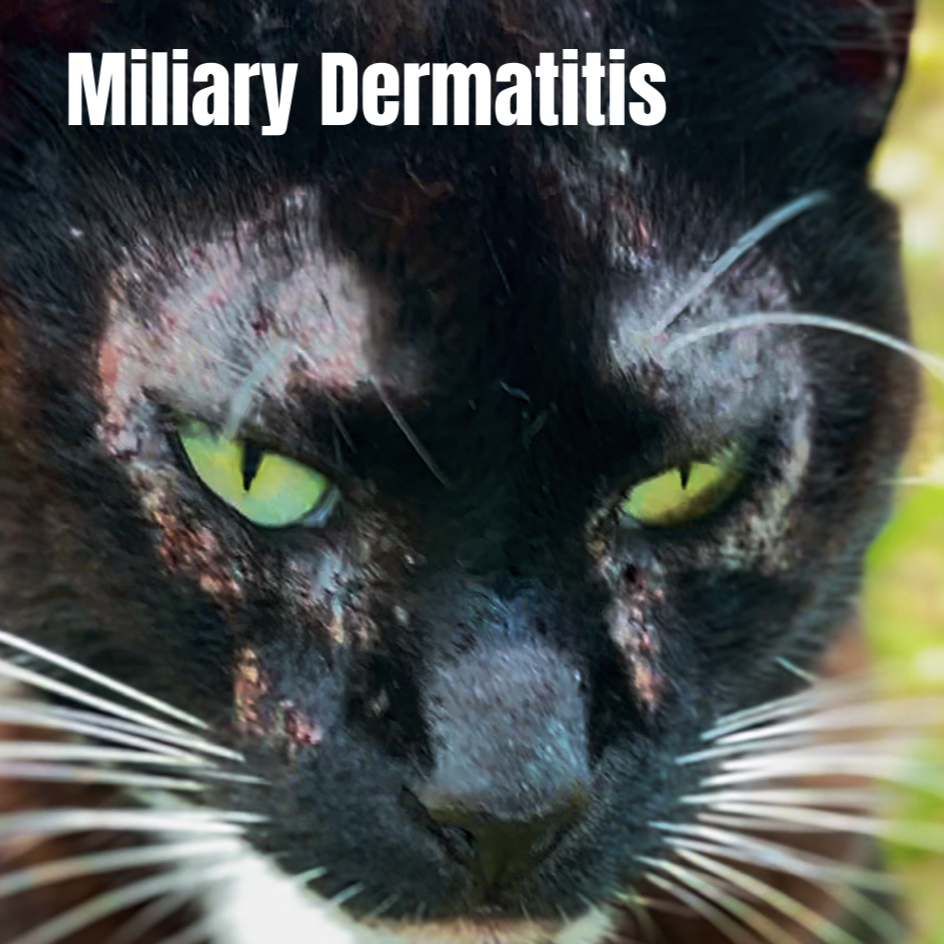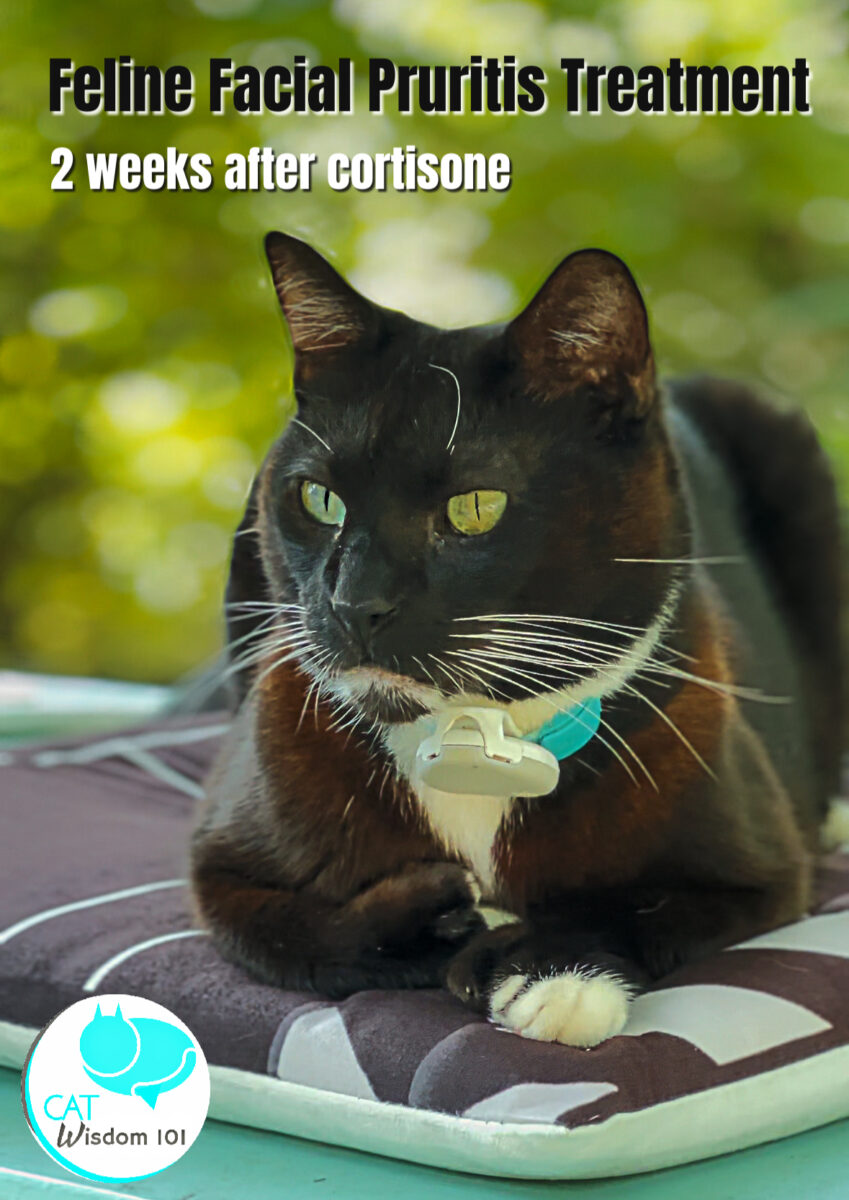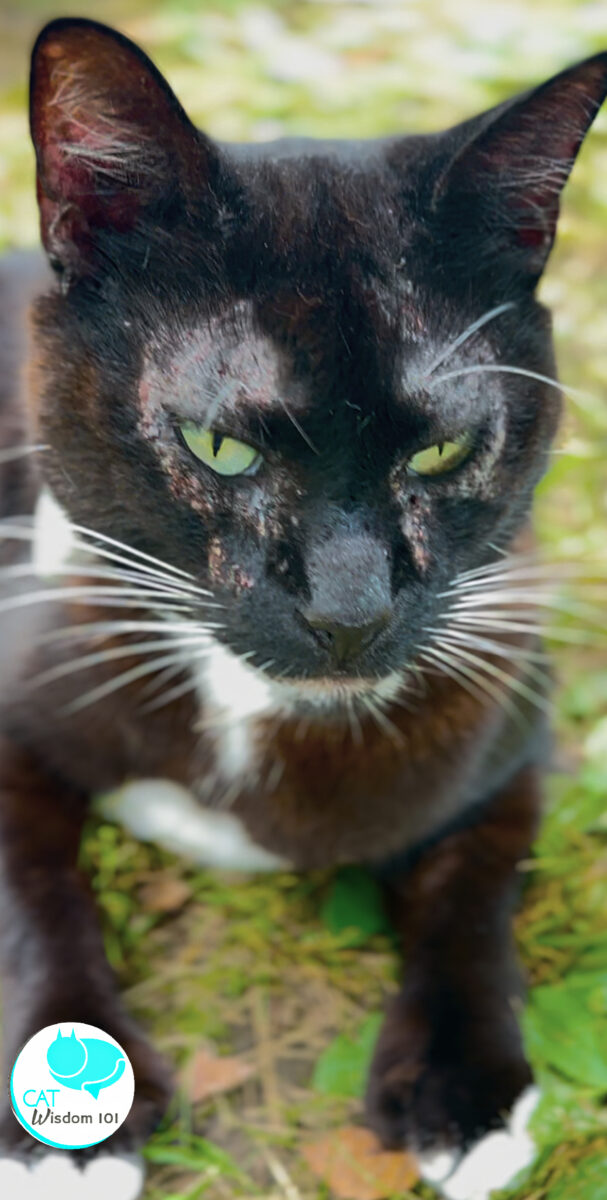Cat allergies: When cat skin tells the tale of itchy face.
This post was inspired by my cat Otto’s recent experience with and successful treatment for facial pruritus.
I’ve seen a lot of cats suffer from itching and discomfort. One of the most common issues is allergies, which can manifest in many different ways. Today I want to focus on two symptoms that cause most cat owners headaches: hair loss and flaky skin on the face.
First, let’s talk about shedding. If your cat is losing hair in patches or has thinning fur, especially around the base of their tail and belly, allergies could be the culprit. Cats with allergies often over-groom themselves, which can be a telltale sign.
First, let me tell you what facial itching actually looks like. It’s not a good look. Otto went from normal to awful within 3 days.
Usually, the hair loss is located above the eyes, but it’s not limited to that area: some cats may lose hair in patches around the ears, while others may experience thinning hair on their cheeks and chin.
Here’s a fun fact: some cats with itchy faces develop a condition called “miliary dermatitis.”
It’s basically a rash that feels like tiny millet seeds under the skin – your cat won’t be happy about you touching it, trust me!
The condition appears as small, crusty bumps, usually around the chin and lips, and sometimes spreading down to the neck, and are often accompanied by intense itching, causing visible discomfort to your cat.


So what causes these allergies? Common triggers include:
1. Environmental allergens (pollen, dust mites, mold)
Environmental allergies, or eczema, are also a big problem. Some are seasonal, like pollen allergies, while others are year-round, like dust mites and mold spores. Some cats are even allergic to human dander. Imagine your cat being allergic to you!
2. Food allergies
Food allergies in cats are less common than environmental allergies, but they can cause similar symptoms, including the hair loss and facial skin problems mentioned earlier. Here’s what you need to know:
Common allergens:
The most common food allergens for cats are usually proteins. Contrary to popular belief, grains are rarely the culprit. Common allergenic proteins include:
1. Beef
2. Dairy products
3. Fish
4. Chicken
5. Eggs
Remember, food allergies can develop at any age, even to foods your cat has been eating without issue for years, so don’t hesitate to consult your vet if you suspect a food allergy.
3. Flea allergy
Now, let’s talk about a less common cause: Flea allergy dermatitis is a real thing, and some cats are so sensitive that even a single flea bite can make them sick.
There’s also a condition called psychogenic alopecia, where cats excessively groom themselves due to stress or anxiety. It’s like the feline version of stress eating, but instead of munching on ice cream, they munch on their own hair.
There’s immediate, where your cat reacts to something right away, and delayed, where it takes days or weeks for symptoms to appear, which is why pinpointing the exact cause can be harder than getting your cat in its carrier on vet day.
The vet suspected that seasonal allergies were the cause of Otto’s hair loss.
Detecting the specific cause can be difficult, but some proven approaches include:
1. Eliminate fleas: Treat your cat to flea treatment even if you can’t see any fleas. You’d be surprised how often this solves the problem.
2. Diet Trial: If flea control doesn’t work, try a hypoallergenic diet for 8-12 weeks. That means no treats or scraps, and only the prescribed food.
3. Environmental testing: If food testing is inconclusive, you may need to check for environmental allergies through intradermal skin testing or blood tests.
Diagnosis takes some time. Your vet will start with a physical exam and some basic testing to rule out other problems like mites or fungal infections. They may recommend a dietary trial, in which you switch your cat to a hypoallergenic diet for a few months. Allergy blood tests are available, but they are not always reliable in cats. They may also do skin tests similar to those humans undergo for allergy testing.
process
Treatment options depend on the cause and may include the following:
– Antihistamines
– Omega-3 fatty acid supplements
– Topical treatments for skin relief
– Immunotherapy for environmental allergies
– Corticosteroids (in severe cases, under strict veterinary supervision)
Treatment depends on the cause, as you’d expect. If it’s a food allergy, you’ll want to consider dietary changes. If it’s an environmental allergy, you might need lifestyle changes and/or medication to suppress the itch. In some cases, you could even get immunotherapy, or allergy shots for cats.
cortisone
The most common treatment is cortisone. Otto was given two weeks of titrated treatment. Healing proceeded rapidly, and within three weeks all his hair had grown back.
Cortisone, or more broadly known as corticosteroids, can be a real game-changer for cats with facial pruritus.
1. How it works: Cortisone is an anti-inflammatory and immunosuppressant. It basically tells your cat’s immune system to calm down, which can be extremely helpful in reducing allergic reactions.
2. Treatment: There are several options: liquids, oral tablets, injections, and even topical treatments. The choice depends on the severity of the problem and your cat’s cooperation (we all know that some cats are masters at taking medicines).
3. Fast acting: One of the big benefits of cortisone is that it often has a fast effect — your itchy cat may start feeling better in just a day or two.
4. Short-term use: Cortisone is typically used as a short-term solution. It’s great for breaking the itch-scratch cycle and giving your cat instant comfort.
5. Potential Side Effects: Like any medication, cortisone is not without its drawbacks. Short-term use can increase thirst and appetite. Long-term use can lead to more serious problems, such as diabetes and a weakened immune system.
6. It’s Not a Panacea: Cortisone treats symptoms but doesn’t address the underlying cause, which is why it’s often used in conjunction with other treatments or as a stopgap until the root cause of the problem is found.
7. Prescription Required: This is not something you can easily buy over the counter. Your vet will need to prescribe it and determine the appropriate dosage for your cat.
8. Taper off gradually: If your cat has been receiving cortisone for more than a few days, it is usually best to taper off the dosage gradually rather than suddenly stopping it.
Remember, although cortisone can be very effective, it’s not suitable for all cats or in all situations, and your veterinarian will weigh the pros and cons based on your cat’s particular case.
Pro tip: If your vet prescribes cortisone, be sure to follow the directions carefully as it is important to take this medication consistently.
So here’s the answer! While cortisone can be a powerful weapon against facial itching, it’s only one piece of the puzzle. Always work closely with your veterinarian to find the best treatment plan for your furry friend.
It’s important to remember: facial itching isn’t just a cosmetic issue. Sure, that bald spot won’t win any beauty contests, but the constant itching can really affect your cat’s quality of life. It can lead to skin infections and behavioral changes that can even affect their sleep. If you notice your cat scratching more than usual, take them in for an immediate check-up.
Finally, let’s talk about prevention: While you can’t always prevent allergies, there are things you can do to help an itchy cat.
Regular grooming will help rid their coat of allergens, using an air purifier and keeping your home clean can help reduce environmental factors, and of course a high-quality diet and regular vet visits are always a good idea.
In my experience, catching and treating allergies early can make a big difference. If you notice your cat shedding hair or crusting skin on its face, address it right away. The sooner you address the problem, the happier and more comfortable your cat will be.
Finally, a word of warning: never try to give your cat any human medications without first consulting your vet, as drugs that are safe for humans can be fatal to cats.
Remember, each cat is unique and what works for one may not work for another. Finding the cause of your cat’s itchy face and the best treatment may take time and patience. But that’s what being a cat owner is all about, isn’t it? Solve the mystery and keep our feline kings happy and healthy.
Otto was back to his old, happy, handsome, healthy self.


So now you know a little more about the world of itchy cat faces, guys. Keep an eye out, have a lint roller ready, and don’t hesitate to consult your vet if you’re concerned. Your cat’s face (and the rest of her) will thank you!
Cat lovers, stay interested in cat care!
love,
Leila and Otto





